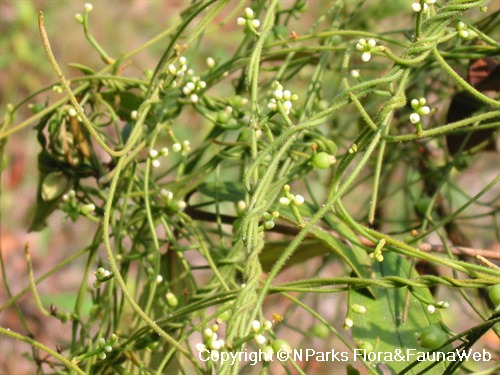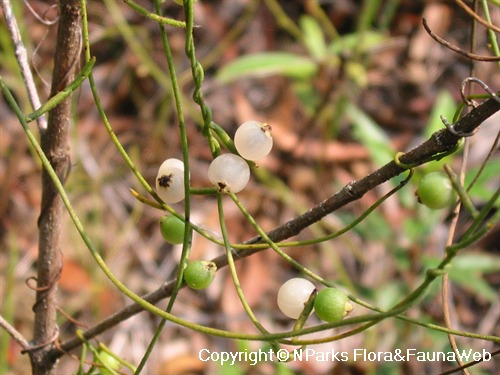
Back
Cassytha filiformis L.
| Family Name: | Lauraceae |
| Common Name: | Chemar Hantu, Doddler-Laurel, Seashore Dodder, Woe Vine, Cemar Batu, Rambut Puteri, Tali Puteri, 无根藤 |
Name
Classifications and Characteristics
| Plant Division | Angiosperms (Flowering Seed Plants) (Dicotyledon) |
|---|---|
| Plant Growth Form | Climber |
| Lifespan (in Singapore) | Perennial |
| Mode of Nutrition | Autotrophic |
| Maximum Height | 8 m |
Biogeography
| Native Distribution | Tropical regions of Africa, Asia, and Australia |
|---|---|
| Native Habitat | Terrestrial (Coastal Forest), Shoreline (Coastal Cliff, Backshore, Sandy Beach, Rocky Beach) |
| Preferred Climate Zone | Tropical |
| Local Conservation Status | Native to Singapore (Least Concern (LC)) |
Description and Ethnobotany
| Growth Form | It is a twining, parasitic plant with long, threadlike stems. The stems are yellow-green, brown, or orange, up to 8 m long, and adhere to trees or shrubs by small, round suckers. |
|---|---|
| Foliage | Its spirally arranged leaves are reduced to tiny scales. |
| Flowers | The bisexual flowers are borne on inflorescences and are sessile. The flowers are white, the outer 3 tepals are ovate while the inner 3 tepals are elliptical. |
| Fruit | Its one-seeded fruits are round berries, 6–9 mm wide, and enclosed in the enlarged, fleshy perianth (structure formed by the non-reproductive flower parts). |
| Others - Plant Morphology | The plant feeds off its host plant via a sucker-like attachment called a haustoria. |
| Habitat | It is common on seashores, scrambling over bushes, trees or thickets, up to 1,600 m altitude. It occurs locally along Mandai Road, Lentor Avenue, Narayanan Chetty Road, in Pulau Semakau, the Western Catchment Area, and Pulau Tekong. |
| Associated Fauna | Its flowers are insect-pollinated. Its fruits are dispersed by birds. |
| Cultivation | It is propagated by seeds. |
| Etymology | Greek Cassytha, after the genus Cuscuta, with which the plant much resembles; Latin fili, a thread; Latin form, shape, referring to the threadlike stems of the species |
| Ethnobotanical Uses | Medicinal: It is considered astringent and diuretic. The stems are also used as a tonic infusion in China, India and Vietnam for piles and diarrhoea. The stems are also used externally for cleaning ulcers and an infusion is used as eyewash. A mixture of the stem with sesamum oil can produce a hair-tonic. Others: The plant is made into a paste for making papers. The stem is used to produce a brown dye. An alkaloid, laurotetanin is present in the plant, and may cause death when taken in sufficient quantities. |
Landscaping Features
| Landscaping | Not suitable for landscape use as it is an aggressive growing, parasitic plant. |
|---|---|
| Usage Hazard - Cons | Toxic Upon Ingestion |
| Usage Hazard - Cons Remarks | Parasitic plant |
Fauna, Pollination and Dispersal
| Fauna Pollination Dispersal Associated Fauna | Bird-Attracting (Fruits) |
|---|---|
| Pollination Method(s) | Biotic (Fauna) |
| Seed or Spore Dispersal | Biotic (Fauna), Abiotic (Water) |
Plant Care and Propagation
| Light Preference | Full Sun |
|---|---|
| Water Preference | Little Water, [Remarks] (It acquires its water from its host plant.) |
| Plant Growth Rate | Fast |
| Rootzone Tolerance | Saline Soils / Salt Spray |
| Propagation Method | Seed |
Foliar
| Foliage Retention | Evergreen |
|---|---|
| Foliar Modification | Scale-like |
| Foliar Type | Simple / Unifoliate |
| Foliar Arrangement Along Stem | Alternate |
| Foliar Attachment to Stem | Sessile |
| Foliar Shape(s) | Non-Palm Foliage |
| Foliar Venation | Pinnate / Net |
Non - Foliar and Storage
| Root Type | Aboveground (Haustorial Root) |
|---|
Floral (Angiosperm)
| Flower & Plant Sexuality | Bisexual Flowers |
| Flower Colour(s) | White, Yellow / Golden |
|---|---|
| Flower Grouping | Cluster / Inflorescence |
Fruit, Seed and Spore
| Mature Fruit Colour(s) | Green, White |
|---|---|
| Fruit Classification | Simple Fruit |
| Fruit Type | Fleshy Fruit , Non-Accessory Fruit |
Image Repository
Others
| Master ID | 67 |
|---|---|
| Species ID | 1363 |
| Flora Disclaimer | The information in this website has been compiled from reliable sources, such as reference works on medicinal plants. It is not a substitute for medical advice or treatment and NParks does not purport to provide any medical advice. Readers should always consult his/her physician before using or consuming a plant for medicinal purposes. |

